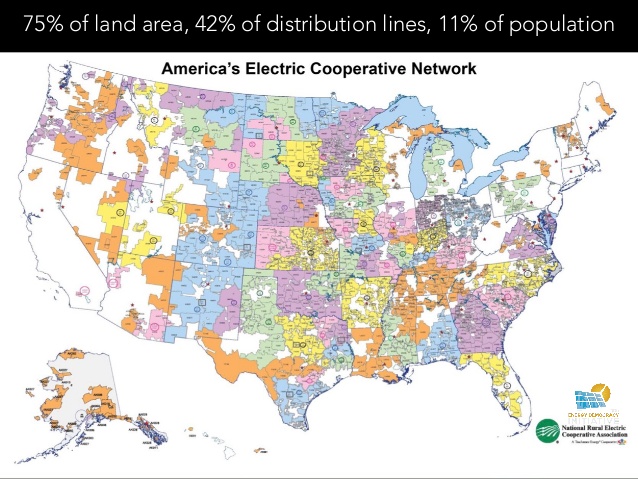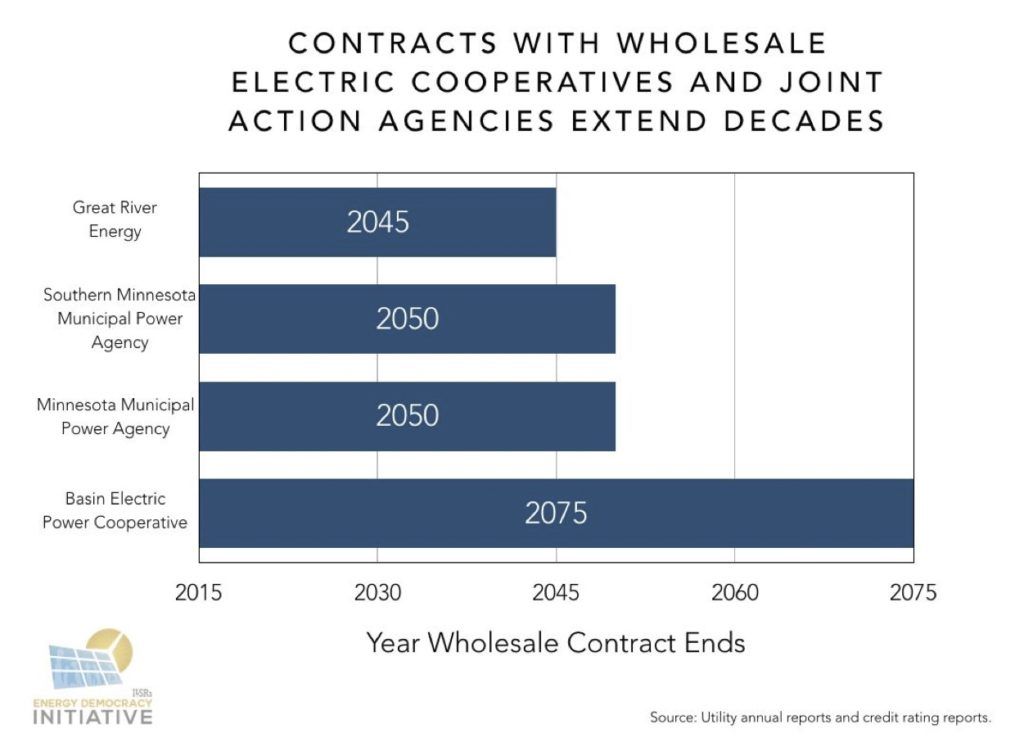Two Rural Electric Cooperatives Overcome Barriers To Clean, Local Energy
Originally published at ilsr.org.
Rural communities formed rural electric cooperatives as a way to get energy where no one else would provide it. In the 21st century, some cooperatives have found an additional economic benefit in pursuing local renewable energy. In the cases of Farmers Electric Cooperative in Iowa and Kit Carson Electric Cooperative in New Mexico, it’s a desire that’s risen from the member-owners up to the leadership.
In this episode of Local Energy Rules (recorded in mid-2018), John Farrell and a few listeners ask questions of the manager and CEO of each cooperative: Warren McKenna of Farmers Electric Cooperative and Luis Reyes of Kit Carson Electric Cooperative. These cooperatives have jumped far ahead of their peers in pursuing clean, local energy in a win-win for the cooperative and its members.

Podcast (localenergyrules): Play in new window | Download | Embed
Rural Electric Cooperatives
Electric co-ops serve an estimated 42 million people in the United States, mainly in rural areas that are not served by an investor-owned utility. Unlike those of other utility companies, customers of rural electric cooperatives are member-owners of the company, able to elect its board of directors and share it any profits.
Farmers Electric
Farmers Electric Cooperative in Kalona, Iowa, is one of the oldest electric cooperatives in the country. It was started in 1916 to serve rural Iowans and is now providing power to over 600 customers in southeastern Iowa.
“We chose to take a partnership with our customers,” said McKenna. “We’re owned by the customer and it’s customer driven.”
Farmers has had the most solar per customer of any utility company in the country, but spread across many different sources. Many customers have solar on their property, others own a share of the co-op’s community solar project, and still more solar is owned by the co-op utility itself.
Want to know more about Farmers Electric Cooperative and their history? Listen to this 2013 podcast or read this in-depth story (complete with video segment).
Kit Carson
Kit Carson Electric Cooperative operates in New Mexico, where it serves over 20,000 members. Initially stymied its wholesale supplier’s limits on local power generation, the co-op broke up with its supplier to have more independence. Now, it’s free to pursue its member-owners’ interest in local solar energy production.
“We wanted to be inclusive,” said Reyes. “We could have put one big array out on acres and acres of property, but that kinda seemed impersonal. We really wanted solar to be personal – that there was an array in your neighborhood and serving your needs specifically, and people then take ownership of that because that’s our array.”
The goal of the co-op is now to fill 100% of their daytime electricity demand with solar by 2022. Reyes started implementing solar in 2002, but this goal is something that the members explicitly asked for through a vote in 2010.
Kit Carson is showing a great example of how rural areas can take control over their energy. “We want to share our success here with others,” said Reyes.
Challenges to Overcome
Since electric cooperatives serve so many people, and cover 56% of the landmass of the US, they have a great potential to invest in renewables. Unfortunately, they face some unique challenges to pursuing renewable energy.
One barrier preventing Kit Carson from investing in renewables was its contract with the larger generation and transmission cooperative, Tri-State Generation and Transmission Association. Tri-State only allowed Kit Carson to generate 5% of its electricity – the rest it had to buy from the association. Luckily, Kit Carson was able to pay a fee and exit the contract. The co-op now has a contract with Guzman Renewable Energy Partners, which will allow it to reach its solar goals.
Listen to this podcast about a Colorado co-op that also fought against Tri-State.
Farmers Electric had more freedom to begin with, but still has a contract for coal power. In the interview, McKenna said that Farmers Electric buys 50% of its power from a coal plant in Illinois. Other cooperatives in the Upper Midwest have contracts that extend for decades.
Cooperatives have also struggled to incorporate member interests in renewable energy due to poor member participation in co-op governing. Although members are co-op owners and can vote to select leadership, turnout for board elections is often abysmally low. With poor participation, co-op boards may be less representative than otherwise. For example, in many states in the south, there is a large disparity between the numbers of minorities and women who are part of co-op boards when compared to the demographics of the population.
Reyes explains how member engagement was key to the co-op’s solar success.
“We just had an education campaign with our members and it appealed to them for different reasons, and we just embraced that instead of trying to tell them why we thought solar was good,” said Reyes. “I think the two-way communication with our members was paramount in making this a success.”
After the robust member engagement, Kit Carson knew what members wanted, and it was solar energy. Reyes lists three primary reasons members want to go solar:
- Solar is cost-competitive with coal power
- Members are concerned about climate change and the environment
- Solar is reliable when backed up with batteries
Both Reyes and McKenna emphasized that batteries will have an important role to play in supporting increasing renewable energy production.
For more on the role of batteries in the renewable energy economy, see ILSR’s report Reverse Power Flow.
Prospects for Rural Communities
Despite the contractual and governance challenges facing many rural electric cooperatives, Kit Carson and Farmers Electric offer hope for rural communities seeking the economic benefits of renewable energy. Cooperatives can buy out of expensive power contracts and develop local renewable energy. Co-op leadership can engage with members and identify how best to meet their interest in clean energy, whether that’s individual member-owned solar or co-op owned solar.
“We needed to make sure that solar was inclusive,” said Reyes. “And our thought was if the low and fixed income cannot participate in these solar programs, then the program is no different than what we have today.”
Inclusivity has been another strong suit of cooperatives, with inclusive energy financing providing access to clean energy and energy efficiency to co-op members in some of the poorest areas of the country.
Listen to this Local Energy Rules podcast of one Kansas electric cooperative that offers tariffed, on-bill financing.
As they did with delivering electricity to America’s Heartland, rural electric cooperatives can lead in bringing renewable energy to rural communities.
“Our story is really a real story, not something you hope happens,” said Reyes. “We’re actually doing it. As we talk, we’re having arrays built. I really do think this is the real deal and this is the future in energy, is giving it back to the people instead of having a central source and delivering it, having a more distributed system that is local and controlled by the local community.”
This article originally posted at ilsr.org. For timely updates, follow John Farrell or Marie Donahue on Twitter, our energy work on Facebook, or sign up to get the Energy Democracy weekly update.
Photo Credit: Farmers Electric Cooperative
Have a tip for CleanTechnica? Want to advertise? Want to suggest a guest for our CleanTech Talk podcast? Contact us here.
Latest CleanTechnica.TV Video

CleanTechnica uses affiliate links. See our policy here.



